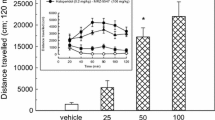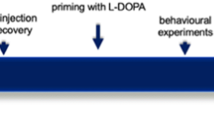Abstract
Objective
Establishment of preclinical method evaluating behavioral protective actions of drugs for Parkinson’s disease was attempted using l-deprenyl (DEP) as a reference drug in 1-methyl-4-phenyl-1, 2, 3, 6-tetrahydropyridine (MPTP)-treated common marmosets.
Materials and methods
Fifteen marmosets received MPTP at 2 mg/kg, subcutaneously (s.c.) per day for three consecutive days. To these marmosets, intragastric (i.g.) administration of DEP at 10 mg/kg was pretreated 2 h before each MPTP administration in DEP3 group and pretreated only in the first MPTP administration day in DEP1 group. As a control, distilled water (DW) was pretreated before each MPTP administration (n = 5 for each of three groups).
Results
In DW group, decreased daily activity counts and increased dysfunction scores were persistently observed for 3 weeks after MPTP. In DEP groups, the similar changes of both levels to those in DW group were temporally observed after MPTP for several days and then the values recovered to the pre-MPTP levels. The results of autoradiography performed after above behavioral observations indicated that markedly lower bindings of [11C]PE2I (ligand for dopamine transporters) were observed at the striatum of DW group marmoset as compared with the striatum of additionally prepared MPTP-free marmoset (n = 5). The bindings in DEP groups were almost the same as in the MPTP-free marmoset brains.
Conclusion
The present preclinical methods using continuous recording of activity of marmosets in their living cages and autoradiography using dopamine transporter ligand might be sensitive for detecting protective actions of drugs for Parkinson’s disease.




Similar content being viewed by others
References
Antkiewicz-Michaluk L (2002) Endogenous risk factors in Parkinson’s disease: dopamine and tetrahydroisoquinolines. Pol J Pharmacol 54:567–572
Barnes NJ, Bradbury AJ, Costall B, Domeney AM, Kelly ME, Naylor RJ (1986) Neuropharmacological manipulations with MPTP. J Neural Transm Suppl 20:47–63
Birkmayer W, Knoll J, Riederer P, Youdim MB, Hars V, Marton J (1985) Increased life expectancy resulting from addition of l-deprenyl to Madopar treatment in Parkinson’s disease: a longterm study. J Neural Transm 64:113–127
Doudet D, Gross C, Lebrun-Grandie P, Bioulac B (1986) Effect of increasing regimens of levodopa on chronic MPTP-induced parkinsonism in monkey; mechanographic and electromyographic data. Electromyogr Clin Neurophysiol 26:711–727
Gerlach M, Riederer P, Przuntek H, Youdim MB (1991) MPTP mechanisms of neurotoxicity and their implications for Parkinson’s disease. Eur J Pharmacol 208:273–286
Geyer MA, Markou A (1995) Animal models of psychiatric disorders. In: Bloom FE, Kupfer DJ (eds) Psychopharmacology: the fourth generation of progress. Raven Press, New York, pp 787–798
Inaji M, Okauchi T, Ando K, Maeda J, Nagai Y, Yoshizaki T, Okano H, Nariai T, Ohno K, Obayashi S, Higuchi M, Suhara T (2005) Correlation between quantitative imaging and behavior in unilaterally 6-OHDA-lesioned rats. Brain Res 1064:136–145
Jenner P (2004) Preclinical evidence for neuroprotection with monoamine oxidase-B inhibitors in Parkinson’s disease. Neurology 63:S13–S22
Jenner P, Marsden CD (1986) The actions of 1-methyl-4-phenyl-1,2,3,6-tetrahydropyridine in animals as a model of Parkinson’s disease. J Neural Transm Suppl 20:11–39
Jenner P, Rupniak NM, Rose S, Kelly E, Kilpatrick G, Lees A, Marsden CD (1984) 1-Methyl-4-phenyl-1,2,3,6-tetrahydropyridine-induced parkinsonism in the common marmoset. Neurosci Lett 50:85–90
Johannessen J (1991) A model of chronic neurotoxicity: long-term retention of the neurotoxin 1-methyl-4-phenylpyridinium (MPP+) within catecholaminergic neurons. Neurotoxicology 12:285–302
Kanda T, Tashiro T, Kuwana Y, Jenner P (1998) Adenosine A2A receptors modify motor function in MPTP-treated common marmosets. Neuroreport 9:2857–2860
Kupsch A, Sautter J, Gotz ME, Breithaupt W, Schwarz J, Youdim MB, Riederer P, Gerlach M, Oertel WH (2001) Monoamine oxidase-inhibition and MPTP-induced neurotoxicity in the non-human primate: comparison of rasagiline (TVP 1012) with selegiline. J Neural Transm 108:985–1009
Kupsch A, Sautter J, Schwarz J, Riederer P, Gerlach M, Oertel WH (1996) 1-Methyl-4-phenyl-1,2,3,6-tetrahydropyridine-induced neurotoxicity in non-human primates is antagonized by pretreatment with nimodipine at the nigral, but not at the striatal level. Brain Res 741:185–196
Landrigan PJ, Sonawane B, Butler RN, Trasande L, Callan R, Droller D (2005) Early environmental origins of neurodegenerative disease in later life. Environ Health Perspect 113:1230–1233
Langston JW, Irwin I, Langston EB, Forno LS (1984) 1-Methyl-4-phenylpyridinium ion (MPP+): identification of a metabolite of MPTP, a toxin selective to the substantia nigra. Neurosci Lett 48:87–92
Lees AJ, Shaw KM, Kohout LJ, Stern GM, Elsworth JD, Sandler M, Youdim MB (1977) Deprenyl in Parkinson’s disease. Lancet 2:791–795
Millan MJ, Di Cara B, Hill M, Jackson M, Joyce JN, Brotchie J, McGuire S, Crossman A, Smith L, Jenner P, Gobert A, Peglion JL, Brocco M (2004) S32504, a novel naphtoxazine agonist at dopamine D3/D2 receptors: II. Actions in rodent, primate, and cellular models of antiparkinsonian activity in comparison to ropinirole. J Pharmacol Exp Ther 309:921–935
Muralikrishnan D, Samantaray S, Mohanakumar KP (2003) d-deprenyl protects nigrostriatal neurons against 1-methyl-4-phenyl-1,2,3,6-tetrahydropyridine-induced dopaminergic neurotoxicity. Synapse 50:7–13
Nagai Y, Obayashi S, Ando K, Inaji M, Maeda J, Okauchi T, Ito H, Suhara T (2007) Progrssive changes of pre- and post-synaptic dopamininergic biomarkers in conscious MPTP-treated cynomolgis monkeys measured by positron emission tomography. Synapse 61:809–819
Nagatsu T (2002) Amine-related neurotoxins in Parkinson’s disease: past, present, and future. Neurotoxicol Teratol 24:565–569
Nomoto M, Jenner P, Marsden CD (1985) The dopamine D2 agonist LY 141865, but not the D1 agonist SKF 38393, reverses parkinsonism induced by 1-methyl-4-phenyl-1,2,3,6-tetrahydropyridine (MPTP) in the common marmoset. Neurosci Lett 57:37–41
Nomoto M, Jenner P, Marsden CD (1986) Alterations in motor behaviour produced by the isomers of 3-PPP in the MPTP-treated marmoset. Eur J Pharmacol 121:123–128
Obata T (2006) Nitric oxide and MPP(+)-induced hydroxyl radical generation. J Neural Transm 113:1131–1144
Palhagen S, Heinonen E, Hagglund J, Kaugesaar T, Maki-Ikola O, Palm R (2006) Selegiline slows the progression of the symptoms of Parkinson disease. Neurology 66:1200–1206
Saji H, Iida Y, Kawashima H, Ogawa M, Kitamura Y, Mukai T, Shimazu S, Yoneda F (2003) In vivo imaging of brain dopaminergic neurotransmission system in small animals with high-resolution single photon emission computed tomography. Anal Sci 19:67–71
Sandler M, Willoughby J, Glover V, Gibb C (1987) Selegiline and the prophylaxis of Parkinson’s disease. J Neural Transm Suppl 25:35–43
Thiffault C, Aumont N, Quirion R, Poirier J (1995) Effect of MPTP and l-deprenyl on antioxidant enzymes and lipid peroxidation levels in mouse brain. J Neurochem 65:2725–2733
Wu RM, Mohanakumar K, Murphy D, Chiueh C (1994) Antioxidant mechanism and protection of nigral neurons against MPP+ toxicity by deprenyl (selegiline). Ann N Y Acad Sci 738:214–221
Acknowledgments
This study was partly supported by a Grant to CIEA for Neuropsychiatric Disease Project from the Ministry of Health, Labor and Welfare, and a Grant to NIRS for Molecular Imaging Program from the Ministry of Education, Culture, Sports, Science and Technology, Japanese Government. The authors express their gratitude to Mr. Hajime Ishii and Ms. Sayaka Ohba for their technical assistance of the behavioral experiment at CIEA.
Author information
Authors and Affiliations
Corresponding author
Rights and permissions
About this article
Cite this article
Ando, K., Maeda, J., Inaji, M. et al. Neurobehavioral protection by single dose l-deprenyl against MPTP-induced parkinsonism in common marmosets. Psychopharmacology 195, 509–516 (2008). https://doi.org/10.1007/s00213-007-0929-2
Received:
Accepted:
Published:
Issue Date:
DOI: https://doi.org/10.1007/s00213-007-0929-2




